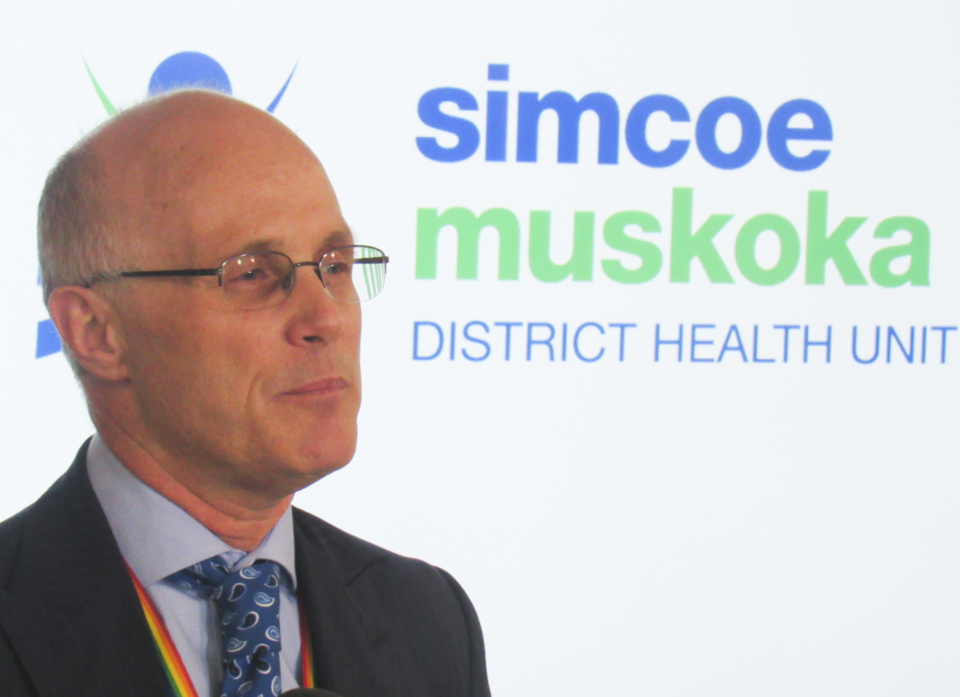It’s been a long time living under intense social and physical restrictions, but the region’s medical officer of health is encouraging residents to carry on.
“I think there’s a shift in mood,” the Simcoe Muskoka District Health Unit's Dr. Charles Gardner said during a media briefing Tuesday.
“I think it’s hard for people to abide by a high alert for a long period of time, and this has been going on for months," he added.
While Ontario — and the Simcoe-Muskoka region — is seeing a surge of cases, Gardner continues to urge people to stick to their households only for any close contact and to practise physical distancing with everyone else.
Such advice from both Gardner and the province’s public health officials was not followed by all this Thanksgiving. According to data collected by the health unit, 43 of the 281 cases (15 per cent) confirmed since Thanksgiving weekend can be attributed to 21 known Thanksgiving gatherings. Those cases span all generations.
According to the health unit, the gatherings consisted of members from the same household along with visiting extended family members and resulted in between one and five cases per cluster. The high-risk contacts from those cases ranged from one contact to 17 contacts per person.
“I think this is important for people to note because we’re going to have other occasions coming up in the future,” said Gardner.
There are several gathering traditions linked to holidays in December. Almost reluctantly, the doctor announced, once again, people should stick to their households only for festive gatherings.
“What we’re asking – sometimes demanding – of people… is unnatural,” Gardner said. “It’s hard for people to accommodate and it’s hard on people and it seems to me we’re seeing some fatigue with that.”
The reproductive rate of the virus in the region is 1.2, meaning every person who tests positive for COVID-19 is infecting, on average, 1.2 other people. At the current rate of spread, the region’s cases would be doubled (from 1,300 to 2,600) by Dec. 23, 2020.
Though parts of the region have relatively low case counts – Muskoka Region, for instance – the southern areas including Bradford and New Tecumseth have incidence rates on par with York Region, which has been relegated to provincial Stage 2 restrictions.
The health unit noted three trends in the region’s transmissions.
First, Gardner said staff have tracked 17 household clusters, three of which are new since last week. Some are family homes and others are students or working individuals who live together in larger groups. He said there are workplace exposures related to such household clusters.
Gardner also said there’s been a “pattern of exposures” among health-care providers outside of hospitals and nursing homes who might not be wearing their full personal protective equipment (PPE). He cited examples such as physiotherapists and massage therapists, and encouraged them to wear both masks and visors while treating patients.
He said the same PPE precautions (mask and eye protection) should be followed by any professional providing an in-person service, such as a hairstylist.
The third transmission trend has been in workplaces. The health unit is tracking two workplace outbreaks in Simcoe County. A manufacturing facility has been in outbreak since Oct. 21 and Gardner said there are now 23 positive staff cases linked to that outbreak. The facility has been closed by the health unit.
The second outbreak is at a food-processing plant, which has been in outbreak since Oct. 5. There are 24 staff cases linked to that outbreak, but no new cases have been reported in the last seven days.
Gardner said it’s important for people to wear face coverings in workplaces, and to maintain physical distancing when they remove their mask to eat. They should not, he said, be removing their masks during break or if they leave public areas because they are still in close proximity to fellow employees.
Part of the reason for masking and physical distancing of “healthy” people is transmission by those who are asymptomatic.
Gardner said people are most contagious with COVID-19 before and as symptoms are just starting to emerge.
“We’ve seen incidences where an asymptomatic individual has been the source of large-scale outbreaks,” he said. “It’s a reason to follow restrictions… early on when you have the least symptoms is when you’re the most contagious.”
The health unit is encouraging people to self-screen for symptoms every day, particularly before leaving the house.
For more information on health unit recommendations for self-screening and other ways to prevent the spread of COVID-19, visit their website.



